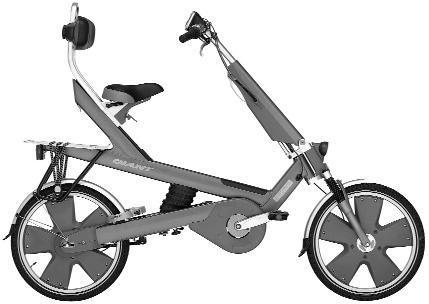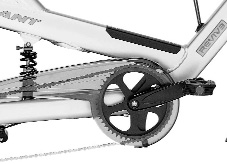 The Giant Revive, it’s fair to say, has been a long time coming.We first heard whispers of a commercially-produced semi-recumbent bicycle some years ago, and eventually saw one in the summer of 2002.The non-assisted versions went on sale the following spring, the electric variant finally arriving in the summer of 2005.
The Giant Revive, it’s fair to say, has been a long time coming.We first heard whispers of a commercially-produced semi-recumbent bicycle some years ago, and eventually saw one in the summer of 2002.The non-assisted versions went on sale the following spring, the electric variant finally arriving in the summer of 2005.
…if ever there was a candidate for electric-assist, the Revive is it…
If ever there was a candidate for electric-assist, the Revive is it – a dead-cool laid- back beastie, but heavy and relatively difficult to pedal, for all sorts of reasons. From Day One, the conventional model looked power-assisted, and now, with the UK launch of the Spirit derivative, it is.
The Revive
 A brief recap. In recumbent terms, the Revive might be described as a short wheelbase semi-recumbent.The frame is alloy throughout, with various bits hung from a solid- looking main tube that drops down from the steering head area, giving a usefully low step-thru, then sweeps back and up over the rear wheel.The wheel is fixed to another frame member that pivots just ahead of the crank and is supported by a spring/damper unit under the seat tube, which swings sharply upwards from the main frame.Wheels are 406mm (20-inch).
A brief recap. In recumbent terms, the Revive might be described as a short wheelbase semi-recumbent.The frame is alloy throughout, with various bits hung from a solid- looking main tube that drops down from the steering head area, giving a usefully low step-thru, then sweeps back and up over the rear wheel.The wheel is fixed to another frame member that pivots just ahead of the crank and is supported by a spring/damper unit under the seat tube, which swings sharply upwards from the main frame.Wheels are 406mm (20-inch).
The Revive is one of the tallest recumbents you’re ever likely to see, so don’t expect the drag co-efficient of a tarmac-scorching HPV racer. On the other hand, it’s dead easy to hop on and off, comfortable to ride, and the drag characteristics are about the same as a much less comfortable drop-handlebar upright, or ‘wedgie’ as the recumbent folk like to call them.The comfort and reasonable drag are excellent news.
 Less satisfactory is the weight, the price and the slightly awkward pedalling position. In its short life, the Revive has been produced in a number of versions, but only two models are currently on sale in the UK both with hub gears – Nexus 7-speed on the Revive DX N7 (£675), and Nexus 8-speed on the more luxurious LXC N8 (£875). Giant is a bit coy about weight, but reports suggest these non-assisted machines weigh at least 19kg (42lb), which compares rather badly with similar conventional bikes.With low drag and high weight, bikes of this kind tend to see more extremes of speed than a traditional bicycle – heart- stopping descents and painfully slow climbs. And that’s where the power-assisted Spirit comes in, because a little assistance goes a long way to even out your progress.
Less satisfactory is the weight, the price and the slightly awkward pedalling position. In its short life, the Revive has been produced in a number of versions, but only two models are currently on sale in the UK both with hub gears – Nexus 7-speed on the Revive DX N7 (£675), and Nexus 8-speed on the more luxurious LXC N8 (£875). Giant is a bit coy about weight, but reports suggest these non-assisted machines weigh at least 19kg (42lb), which compares rather badly with similar conventional bikes.With low drag and high weight, bikes of this kind tend to see more extremes of speed than a traditional bicycle – heart- stopping descents and painfully slow climbs. And that’s where the power-assisted Spirit comes in, because a little assistance goes a long way to even out your progress.
Revive Spirit
 At £1,499, the Spirit is the most expensive electric bike in the UK, by several hundred pounds. It’s also the most sophisticated: lithium-ion battery, integral trip computer, automatic halogen light and many other cumfy luxuries. Strangely enough, given the quality of the equipment, the Spirit is fitted with one of the world’s most basic hub gears; Shimano’s three-speed Nexus.We express surprise because this hub is also available in Auto-D form, and an automatic hub would seem ideal for a laid- back flagship like the Spirit. And this year, Shimano has introduced something called Di2 cyber Nexus, bringing together its generally well considered eight-speed hub with a front hub-powered computer, auto shift mechanism, auto suspension, auto lights, and… well, you get the idea.
At £1,499, the Spirit is the most expensive electric bike in the UK, by several hundred pounds. It’s also the most sophisticated: lithium-ion battery, integral trip computer, automatic halogen light and many other cumfy luxuries. Strangely enough, given the quality of the equipment, the Spirit is fitted with one of the world’s most basic hub gears; Shimano’s three-speed Nexus.We express surprise because this hub is also available in Auto-D form, and an automatic hub would seem ideal for a laid- back flagship like the Spirit. And this year, Shimano has introduced something called Di2 cyber Nexus, bringing together its generally well considered eight-speed hub with a front hub-powered computer, auto shift mechanism, auto suspension, auto lights, and… well, you get the idea.
…an auto hub would seem ideal for a laid-back flagship like the Spirit…
In the end, one assumes, Giant had to stop specifying equipment, to bring the Spirit in at a just manageable price.Weight must have been a problem too. Semi-recumbents with bodywork look oh so cute on the CAD screen, but every panel and bit of trim adds a few grams, and on a bicycle, weight is a real killer.To be fair, given the weight of the non- assisted versions, the Spirit does rather well at 33.2kg complete with battery.
In electric bike terms, that’s well below the average weight, but a few kilograms heavier than the Ezee Sprint, and a lot heavier than Giant’s own featherweight Twist models, which start at 22.2kg. Incidentally, if you’re one of those people who look at things in purely practical terms, the Spirit is completely outclassed by the Twist. Against the basic Twist Lite, it costs 67% more, weighs 50% more and offers 17% less range. Clearly, if it doesn’t triumph in some other department, it’s doomed.
What the naked facts and figures don’t convey is style, something the Spirit exudes from most of its pores. Put it this way, it’s the only bike that drew a crowd just to see the box opened. Giant took a gamble introducing a recumbent, but they got the design broadly right.The styling looks flash enough to tempt snazzy Kings Road types, while the soft greys and blues of the colour scheme will appeal to doddery greys promenading the Costa del Sol.This really is the bike for everyman and everywoman, provided, of course, they have fifteen hundred quid burning a hole in their pocket.
On the Road
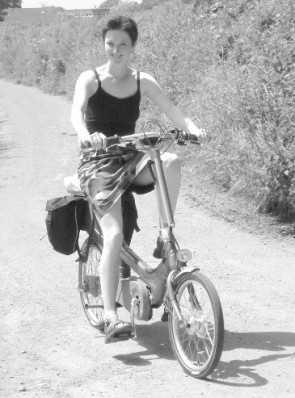
These panniers are small, but there’s plenty of room for full size ones
By and large, the Panasonic power unit fits quite neatly into the Spirit.The motor/gearbox sits where the bottom bracket would be, in the suspended part of the frame, and the tiny li-ion battery is secreted away in a streamlined box behind the seatpost and under the rack. The high rack gives plenty of room for full- size panniers or indeed – with the addition of a couple of footpegs – a small person. Giant’s lawyers have gone mad on this one, ruling out any sort of child seat on pain of death. That’s a shame, because it’s a roomy, sprung platform that could be very effective for dropping little Tarquin off at school. Giant suggests a maximum load of 15kg, but the rack is a rugged affair, so we’d guess that a touring load of twice that amount would be secure. Usefully, the rack is within easy reach, so mobile phone, camera or binoculars are just where you want them. Less usefully, the rack bars are too wide for standard pannier clips.
With no fewer than five height/reach adjusters, the Revive will fit almost anyone. Giant claims a range from 5′ to 6′ 5″ tall, something that we can more or less confirm. The saddle slides along a steeply inclined stem like any other bike, but in this case there’s also a lumbar support that should nestle comfortably in the small of the back and a saddle fore/aft adjuster.This – to put it in the crudest possible terms – is a bottom-sizing gauge. Pert, compact bottoms will be more comfortable with the saddle back, whilst wobbly couch-bums will prefer the saddle forward.
Having wiggled your nether regions into position, the next task is to move the handlebar stem back and forth and up and down to find a comfortable position. Both operations are controlled with one clever quick-release, and fine tuning doesn’t seem to be as critical as it would be on a conventional bike. In practice, adjustment of the saddle and handlebars isn’t usually necessary, with most people under six foot sharing the same settings. Even where adjustments are needed, they’re quick and easy to make. From this point of view, the Revive is a practical multi-user machine.
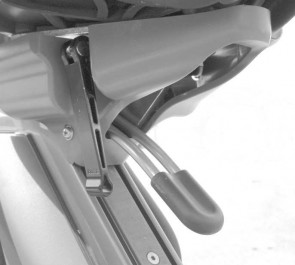
Saddle fore and aft adjuster on the left and height adjuster on the tends to make the right.The saddle runs in the two inclined tracks. suspension bob up
Once you’re comfortable, it’s time to fiddle with the suspension spring pre-load and damper rate.The damper knob is easy, but unlike the cheaper DX, the knurled spring adjuster ring is rather tucked away on the Spirit, making this operation a bit difficult. On our bike, the pre- load was set right at the wobbly couch-bum end of the range, so we had to do some fiddling to get enough suspension movement.
On a conventional bike, pedal force platform.The battery lives under here and down, but this with a semi- recumbent, especially a power-assisted one, so the spring and damper can be set softer than normal, giving a real ‘magic carpet’ ride. ‘This’, said one very occasional bicycle rider, ‘doesn’t feel like a bicycle at all!’ That sort of comment will bring smiles and nods of approval in the Giant boardroom.
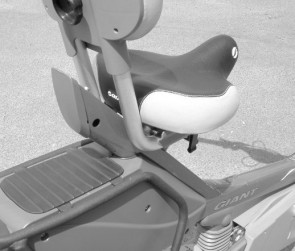
Saddle, lumbar support is less of a problem and rear rack
Rather surprisingly, the Revive has no suspension at the front, so the front tyre pressure needs to be kept quite low.We chose the maximum of 55psi at the rear, but only 20psi in the lightly-loaded front tyre.That’s acceptable, provided you bear in mind that a recumbent cannot be ‘lifted’ over bumps like a conventional bike, so kerbs must be tackled with some caution.
Handling is relaxed and unspectacular.At low speed, the bike goes more or less where you point it, but on a fast bend, it usually needs some sort of corrective flick halfway round. No real problem, but adding a little excitement to an otherwise uneventful ride. Without power, the lack of gear range is all too obvious.The Nexus hub gives a bottom ratio of 45”, middle of 61” and top of 83” – spot-on for power-assist, but a bit high for a heavy bike on muscle-power alone.That said, the Spirit trogs along quite well in flattish terrain, provided you don’t mind being overtaken by old ladies on rusty shoppers.
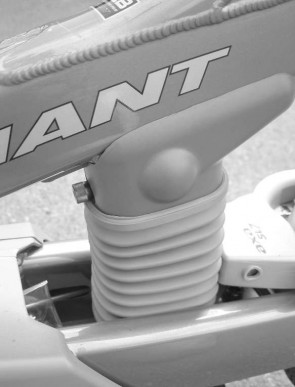
The suspension is enclosed. Note the damper adjuster knob
Power is brought in by pressing a big red button, which unleashes a high-tec bleeping noise and some rather ineffectual power-on-demand when the pedals are turned. At low speed, the motor is surprisingly noisy, making the sort of whining noise that Foden lorries used to emit on gradients.That might be a bit unfair, but it’s certainly noisier than the Twist: a background whine, with overtones of Tardis. Grumbling and whining thus, the Spirit accelerates painfully to 12mph before running out of steam (although oddly enough, the motor continues to run quietly in the background right up to 15mph, but without doing any useful work). If that was the end of the story, Giant would be in big trouble, but the Spirit also has a twistgrip and a lock-button labelled ‘cruise’.
It took us a while to get the hang of all this. Basically, the default setting is what you might call ‘economy’ mode (‘Pedal Activated Power’ in Giant-speak), and the twistgrip can be used to dial in a bit more oomph (‘Variable Power Control’). For long boring ascents, the level of assistance can also be locked with the ‘cruise’ button, keeping output at the chosen level until you brake or stop pedalling.
This all sounds a bit complicated, but it works. If you’re just cruisin’, switch on and pedal gently away at up to 12mph. If you’re late for work, lock the twistgrip on full and you’ll spurt off.Well, perhaps ‘spurt’ is a bit strong.We didn’t dare dismember the power unit to get the figures, but the Li-ion unit is definitely less powerful than the older NiMh device fitted to the Twist. On the flat, speed rises at a reasonable rate to the legal limit of 15mph, at which point the motor cuts out rather abruptly. If your poor legs can’t keep up, speed falls until the power pops abruptly back on, continuing to ‘hunt’ in and out of engagement for as long as speed stays in the 15-16mph zone.
The reason for this rather crude behaviour is that the Spirit is designed for the US market where (in most states) power is allowed to top-out at 18mph. For Europe, and other 24km/hr markets, the top speed is capped using the speedometer sensor on the back wheel. So if you’re very very late for work, you can swing the speedo magnet aside, disabling the speed limiter. Riding an electric bike at 18mph is a bit naughty, but a mere piffle against driving a ton of motor car at 50mph in a 30mph limit whilst blahing into a mobile phone and lighting a cigarette. Quite common in these parts.
In any event, the Spirit will only keep up 18mph under the most favourable conditions.The Giant Twist Lite will stomp up quite steep hills, but the reduced human and electrical input on the Spirit make it wilt very quickly.The basic PAP power setting allows you to struggle up gradients of perhaps 10% (1:10), but you’ll need to use all the gears, and it’s a slow process.Wind the twistgrip fully open, and the motor is zesty enough to tackle 12.5% (1:8) with reasonable ease, and climb 17% (1:6) with a fair bit of effort and some odd clonks and groans (not all of them from the rider). If you try rushing the gear changes, the Nexus hub adds some odd noises of its own, but we found the change improved with use.
Clearly, anyone expecting to sprint across the Lake District with a full touring load will be disappointed. A crank-motor of this type can be adapted for hill-climbing by fitting a larger rear sprocket, but this obviously lowers all the gears. A better solution would be to fit more gears, such as the 8-speed Di2 Cyber Nexus, or whatever Shimano calls it. Our advice is to test the Spirit on a familiar hill, if you can find a willing dealer.
Range
 Range on full power is so- so.There are three capacity lights: On our ‘mountain course’, the first popped off at four miles and the second at six miles, which almost caused us to abort the test. In practice, the gauge is a bit hit- and-miss, because we soon had two lights on again. Four miles on we were back with one, at 14 miles it began to flash, and the end came abruptly at 16.2 miles. Average speed was 13.7mph – quite low by modern electric bike standards, particularly considering the rapid descents. In flat country, we managed 17.4 miles at 14mph, which is even more disappointing.
Range on full power is so- so.There are three capacity lights: On our ‘mountain course’, the first popped off at four miles and the second at six miles, which almost caused us to abort the test. In practice, the gauge is a bit hit- and-miss, because we soon had two lights on again. Four miles on we were back with one, at 14 miles it began to flash, and the end came abruptly at 16.2 miles. Average speed was 13.7mph – quite low by modern electric bike standards, particularly considering the rapid descents. In flat country, we managed 17.4 miles at 14mph, which is even more disappointing.
By comparison, a Giant Twist will deliver about 20 miles from a battery of similar capacity.That said, the NiCd battery on the Twist weighs 3.9kg, and the Li-ion battery on the Spirit weighs only 2.1kg, so if you can afford £350, a spare battery will double the range without adding noticeably to the weight of the bike. Incidentally, the standard battery has a 144Wh capacity, but Panasonic also produce a tiny 86Wh unit and has just introduced a bigger version of 173Wh. If these fit the Spirit – and no one can tell us if they do – they would add greatly to its flexibility.
There’s more good news if you have the will power to leave the twistgrip alone, because this increases the range a good deal. After completing our full power run, we gave the battery a brief 2-hour charge (about 60%) and set off for home, covering the same 16 miles fairly easily with careful power management. Interestingly, average speed was not much less, at 12.5mph. It’s a bit difficult to put a figure on maximum range under gentler conditions, because so many variables are involved, but our experience suggests 25 miles or so.
…none of the arm, finger, neck and bottom aches that bicycling sometimes inflict…
One thing we can say is that the Spirit is at its best on long rides in rolling open country. In town, the gears crash and the motor whines and grumbles, but once up to 15mph (or 18mph) the power unit becomes less obtrusive and the bike proves surprisingly comfortable. After an hour and a half in the saddle, we experienced none of the arm, finger, neck and bottom aches that bicycling sometimes inflicts.The only slightly negative aspect is that the large saddle and backrest can get a bit sweaty after a while. Still, you can’t have everything.There was general agreement that long-distance comfort was the Spirit’s strongest card.
Almost without exception, riders praised the comfort, the visibility, the security of the low step-thru and the gentle assistance that dealt very well with nagging headwinds and rolling hills.
Charger and Accessories
Sliding the battery out looks easy enough, but it’s a two-handed job – one hand to turn the key and the other to pull the battery handle. If it’s tight, as ours was, it’s liable to free rather explosively, trapping your fingers painfully behind the rack tubes. If they’re all the same, this is a serious design fault, because most people would be unable to charge the battery without help.
The compact charger looks similar to the NiMH device sold with early Twist models, but it has no warning lights, the state of charge being determined by a row of LEDs on the battery. Like all Li-ion chargers, the Spirit charger is a complex animal, the technology being necessary to prevent the cells getting out of ‘sync’ with each other. Giant claims a charge time of four hours, but this proved slightly pessimistic.The primary charge takes about three hours and 20 minutes, plus another 20 minutes or so for the last few dregs. Not quite as rapid as filling a petrol tank, but in the electric bike world, three hours for a 95% charge is pretty good.
Based on the power consumed from the mains supply, fuel consumption is around 12.5Wh/mile, which is a bit on the high side, particularly for such a modest average speed. If we can believe the quoted battery capacity of 144Wh, we get a figure of 8.7Wh, which sounds much more impressive.With the bicycle costing £1,499, and replacement batteries at £350 a pop, it is hardly surprising that running costs are the highest we’ve seen. Our estimate is 11.2p per mile, or about twice as expensive as the cheapest machines.
Most of the accessories have been touched on elsewhere.We were impressed by the integral speedometer/computer in the ‘instrument nacelle’. Unfortunately, thanks to the threat of weather and vandalism, this is removable, and we had a few problems with the quick-release catch, which is hard to operate and liable to fail on the road.The computer never quite fell out, but once loose it stops working, which can be annoying.
Lighting is excellent.The Spanninga Ultra Xs rear light is a dynamo standlight version of the Ultra Xba fitted to the Twist Comfort – bright and very effective.The Spanninga Radius Auto headlight is a bit less successful. Like the B&M Oval lamp fitted to the Twist Comfort, this is an automatic system, feeding the front and rear light with power when it senses low light levels. But in this case, all three options – off, on and auto – are on one switch, out of reach on the headlamp. It’s fiddly to use, and finding the ‘auto’ setting can mean a lot of frustrating wheel spinning and head scratching. After a week or so, the rubber cap popped off the switch, which could have allowed rain straight into the electronics – a recipe for disaster. Once you get it working, automatic is excellent, turning on the powerful lights under trees or bridges, and even during gloomy weather.
Brakes are the reliable, but rather stodgy Nexus roller hubs.When new, these are weak, spongy and lacking in feel, but they do eventually run-in to give reasonable performance. Roller brakes can overheat on long descents, but they’re unaffected by water or oil contamination and require very little maintenance.
Conclusion
…the comfort and relaxed riding style will find many converts…
We’d hate to leave the impression that the Spirit offers more problems than advantages.That might seem true on paper, but for all its flaws, it generates a feel good factor that’s difficult to quantify – let’s just say it left everyone smiling. Unusually in our experience, even the most sceptical were won over, and everyone loved riding it.The Spirit isn’t very fast, but it can be a lot of fun on twisty descents, and on the long climb back up again, which is more than you can say for the unassisted versions.This sort of machine isn’t ideal for city commuting, but it strikes a good compromise: high enough to be safe in traffic, but low enough and long- legged enough to tackle a round daily commute of 15-20 miles or so, provided the hills aren’t too taxing. In practice, most purchasers will be older leisure riders, and for this market, the comfort and relaxed riding style will find many converts. Is it worth £1,500? Not in our book, perhaps, but if you’re finding a conventional bike hard work, it almost certainly is. Overall – rather to our surprise – we like it.
Specification
Giant Revive Spirit £1,499 .Weight Bike 31.1kg Battery 2.1kg Total 33.2kg (73lb) . Gearing Nexus 3-spd hub . Ratios 45″ 61″ 83″ . Battery Lithium-ion . Capacity144Wh . Spare battery £350 . Range 16.2 miles . Full charge 3hr 40m . Fuel consumption Overall 12.5Wh/mile Running costs 11.2p/mile . Manufacturer Giant Bicycles. UK distributor Giant UK Ltd tel 0115 977 5900 mail info@giant-uk.demon.co.uk
![]()


 Recumbent bikes and trikes are cumbersome things, which helps to explain why they remain relatively unpopular for day-to-day use, although for recreation and sheer entertainment, laid-back cycling is unbeatable.
Recumbent bikes and trikes are cumbersome things, which helps to explain why they remain relatively unpopular for day-to-day use, although for recreation and sheer entertainment, laid-back cycling is unbeatable.
 If you haven’t ridden a well-sorted recumbent trike, you’ve missed out on one of life’s Great Experiences. And by any standards, this well-balanced and agile, yet forgiving, machine is an experience you’re unlikely to forget in a hurry. Like all the best mid-engined sports cars, geometry and weight distribution have been chosen to give handling that’s broadly neutral – in other words, should you over-cook things on a sharp bend, the GT3 will neither plough straight on, or head for the apex.We rode the trike in all sorts of conditions, with a variety of tyre pressures and several drivers, and the thing cornered throughout as though on rails.This seems to hold true on dry surfaces, wet surfaces and – a Somerset speciality – manure-covered surfaces.You need to concentrate, because things happen very quickly when you’re sitting on the ground, but we’d guess that’s part of the fun with a mid-engined sports car too.With a bit of familiarity, you soon find yourself cruising through corners that would send a cyclist sliding into the hedge. Once in a while, the front Primo tyres scrabble for grip, and occasionally the rear end ducks and dives on a bump, but at bicycle speeds, there’s plenty in reserve.
If you haven’t ridden a well-sorted recumbent trike, you’ve missed out on one of life’s Great Experiences. And by any standards, this well-balanced and agile, yet forgiving, machine is an experience you’re unlikely to forget in a hurry. Like all the best mid-engined sports cars, geometry and weight distribution have been chosen to give handling that’s broadly neutral – in other words, should you over-cook things on a sharp bend, the GT3 will neither plough straight on, or head for the apex.We rode the trike in all sorts of conditions, with a variety of tyre pressures and several drivers, and the thing cornered throughout as though on rails.This seems to hold true on dry surfaces, wet surfaces and – a Somerset speciality – manure-covered surfaces.You need to concentrate, because things happen very quickly when you’re sitting on the ground, but we’d guess that’s part of the fun with a mid-engined sports car too.With a bit of familiarity, you soon find yourself cruising through corners that would send a cyclist sliding into the hedge. Once in a while, the front Primo tyres scrabble for grip, and occasionally the rear end ducks and dives on a bump, but at bicycle speeds, there’s plenty in reserve. Hill climbing is a bit disappointing, not because the GT3 climbs particularly slowly, but because the climbs are markedly slower than the descents. Actually, the trike maintains a good pace on the sort of mild nagging gradients that might depress a bicyclist, but on steeper climbs, the bicycle is quicker, leaving the trike rider to sit it out and think about the fun they’ll have going down the other side.
Hill climbing is a bit disappointing, not because the GT3 climbs particularly slowly, but because the climbs are markedly slower than the descents. Actually, the trike maintains a good pace on the sort of mild nagging gradients that might depress a bicyclist, but on steeper climbs, the bicycle is quicker, leaving the trike rider to sit it out and think about the fun they’ll have going down the other side.



 It’s a common grumble amongst cycle-minded parents that children’s machines are largely unfit for purpose. Childrens bicycles tend to be crude MTB or BMX-style machines, garishly painted with trick non-functional suspension and a total weight in the almost unliftable region. Sadly, the accent – as with most bicycle-related activities in the UK – is on leisure, rather than practical A to B travel.Touring bikes and get-to-school machines are almost unknown for little people, which is a shame because you’re unlikely to get enthusiastic about riding a bike to school, shops, college and so on if you’re using the wrong tool for the job.The KMX Kart does nothing to improve the situation, because in form and function, it’s about as leisure-orientated as they come, but it’s different, and it might just help to break the mould, demonstrating that alternative and much more interesting HPVs exist.
It’s a common grumble amongst cycle-minded parents that children’s machines are largely unfit for purpose. Childrens bicycles tend to be crude MTB or BMX-style machines, garishly painted with trick non-functional suspension and a total weight in the almost unliftable region. Sadly, the accent – as with most bicycle-related activities in the UK – is on leisure, rather than practical A to B travel.Touring bikes and get-to-school machines are almost unknown for little people, which is a shame because you’re unlikely to get enthusiastic about riding a bike to school, shops, college and so on if you’re using the wrong tool for the job.The KMX Kart does nothing to improve the situation, because in form and function, it’s about as leisure-orientated as they come, but it’s different, and it might just help to break the mould, demonstrating that alternative and much more interesting HPVs exist.


 The KMX is a wind-cheating recumbent and – within the limitations of a 60″ gear and so-so tyres – deceptively fast. On modest downgrades, the KMX rapidly gathers pace into the 20+mph zone, even into a blustery headwind.Twenty mph may not sound much, but when you’re this close to the ground, it seems a lot faster, an impression heightened by the quick and responsive steering. At higher speeds, pilotage can get a bit hairy on ‘typical’ road surfaces – bumps being a big problem, with even minor pot-holes threatening to dislodge you from the seat.The sort of small kerbs that give a minor jolt on a bicycle will send kids bouncing out of the KMX, feet flailing the air.This is partly the result of having to relearn all the techniques for bump control that we instinctively learn on a bicycle, but it’s also an inherent disadvantage with 12″ tyres. Rough ground is not their forte.
The KMX is a wind-cheating recumbent and – within the limitations of a 60″ gear and so-so tyres – deceptively fast. On modest downgrades, the KMX rapidly gathers pace into the 20+mph zone, even into a blustery headwind.Twenty mph may not sound much, but when you’re this close to the ground, it seems a lot faster, an impression heightened by the quick and responsive steering. At higher speeds, pilotage can get a bit hairy on ‘typical’ road surfaces – bumps being a big problem, with even minor pot-holes threatening to dislodge you from the seat.The sort of small kerbs that give a minor jolt on a bicycle will send kids bouncing out of the KMX, feet flailing the air.This is partly the result of having to relearn all the techniques for bump control that we instinctively learn on a bicycle, but it’s also an inherent disadvantage with 12″ tyres. Rough ground is not their forte. Lights are not provided, and although the KMX comes with front and rear reflectors, the rear example is too low to satisfy the vehicle lighting regulations. However, a few hours fiddling would produce suitable brackets to place front and rear reflectors and lamps at a legal height. If anything, it’s probably safer to ride a recumbent at night, provided it lights up like a Christmas tree. Forget the law – fit everything, including a fairy wearing a gold lamé tu-tu. If nothing else, it’ll give the Old Bill a laugh.
Lights are not provided, and although the KMX comes with front and rear reflectors, the rear example is too low to satisfy the vehicle lighting regulations. However, a few hours fiddling would produce suitable brackets to place front and rear reflectors and lamps at a legal height. If anything, it’s probably safer to ride a recumbent at night, provided it lights up like a Christmas tree. Forget the law – fit everything, including a fairy wearing a gold lamé tu-tu. If nothing else, it’ll give the Old Bill a laugh.

